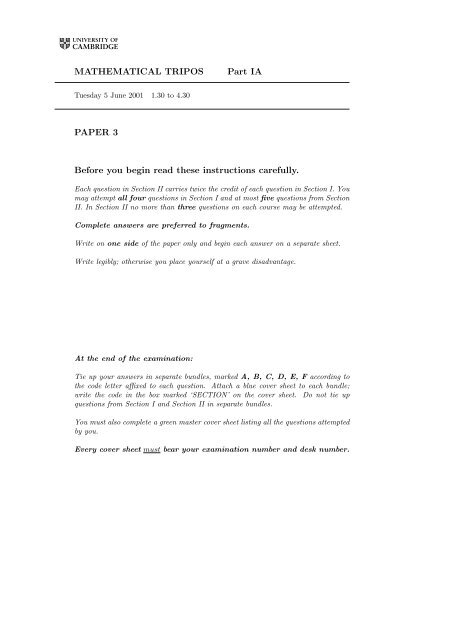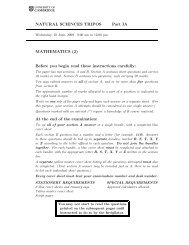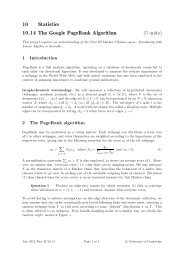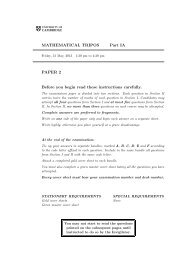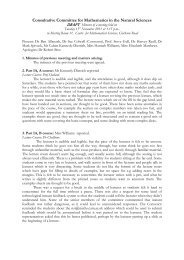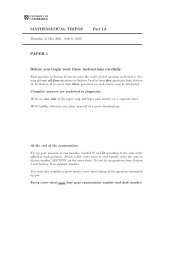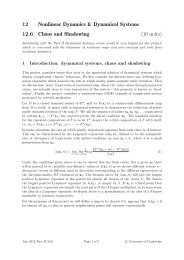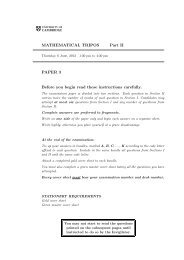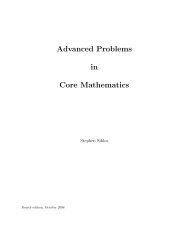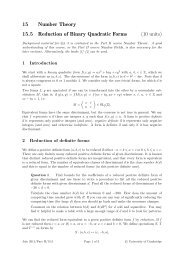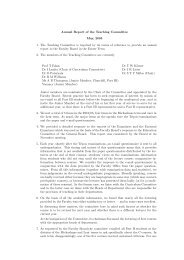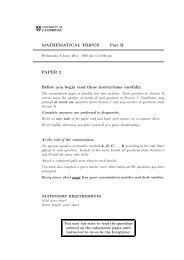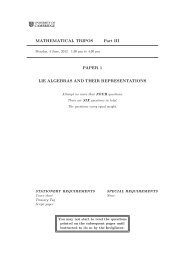MATHEMATICAL TRIPOS Part IA PAPER 3 Before you begin read ...
MATHEMATICAL TRIPOS Part IA PAPER 3 Before you begin read ...
MATHEMATICAL TRIPOS Part IA PAPER 3 Before you begin read ...
You also want an ePaper? Increase the reach of your titles
YUMPU automatically turns print PDFs into web optimized ePapers that Google loves.
<strong>MATHEMATICAL</strong> <strong>TRIPOS</strong><br />
<strong>Part</strong> <strong>IA</strong><br />
Tuesday 5 June 2001 1.30 to 4.30<br />
<strong>PAPER</strong> 3<br />
<strong>Before</strong> <strong>you</strong> <strong>begin</strong> <strong>read</strong> these instructions carefully.<br />
Each question in Section II carries twice the credit of each question in Section I. You<br />
may attempt all four questions in Section I and at most five questions from Section<br />
II. In Section II no more than three questions on each course may be attempted.<br />
Complete answers are preferred to fragments.<br />
Write on one side of the paper only and <strong>begin</strong> each answer on a separate sheet.<br />
Write legibly; otherwise <strong>you</strong> place <strong>you</strong>rself at a grave disadvantage.<br />
At the end of the examination:<br />
Tie up <strong>you</strong>r answers in separate bundles, marked A, B, C, D, E, F according to<br />
the code letter affixed to each question. Attach a blue cover sheet to each bundle;<br />
write the code in the box marked ‘SECTION’ on the cover sheet. Do not tie up<br />
questions from Section I and Section II in separate bundles.<br />
You must also complete a green master cover sheet listing all the questions attempted<br />
by <strong>you</strong>.<br />
Every cover sheet must bear <strong>you</strong>r examination number and desk number.
2<br />
SECTION I<br />
1F Algebra and Geometry<br />
( )<br />
a b<br />
For a 2 × 2 matrix A = , prove that A<br />
c d<br />
2 = 0 if and only if a = −d and<br />
bc = −a 2 . Prove that A 3 = 0 if and only if A 2 = 0.<br />
[Hint: it is easy to check that A 2 − (a + d)A + (ad − bc)I = 0.]<br />
2D Algebra and Geometry<br />
Show that the set of Möbius transformations of the extended complex plane<br />
C ∪ {∞} form a group. Show further that an arbitrary Möbius transformation can<br />
be expressed as the composition of maps of the form<br />
f(z) = z + a, g(z) = kz and h(z) = 1/z .<br />
3C<br />
Vector Calculus<br />
For a real function f(x, y) with x = x(t) and y = y(t) state the chain rule for the<br />
derivative d dtf(x(t), y(t)).<br />
By changing variables to u and v, where u = α(x)y and v = y/x with a suitable<br />
function α(x) to be determined, find the general solution of the equation<br />
x ∂f ∂f<br />
∂x<br />
− 2y<br />
∂y = 6f .<br />
4A<br />
Vector Calculus<br />
Suppose that<br />
u = y 2 sin(xz) + xy 2 z cos(xz), v = 2xy sin(xz), w = x 2 y 2 cos(xz).<br />
Show that u dx + v dy + w dz is an exact differential.<br />
Show that<br />
∫ (π/2,1,1)<br />
(0,0,0)<br />
u dx + v dy + w dz = π 2 . Paper 3
3<br />
SECTION II<br />
5F<br />
Algebra and Geometry<br />
Let A, B, C be 2 × 2 matrices, real or complex. Define the trace tr C to be the sum<br />
of diagonal entries C 11 +C 22 . Define the commutator [A, B] to be the difference AB −BA.<br />
Give the definition of the eigenvalues of a 2 × 2 matrix and prove that it can have at most<br />
two distinct eigenvalues. Prove that<br />
a) tr [A, B] = 0,<br />
b) tr C equals the sum of the eigenvalues of C,<br />
c) if all eigenvalues of C are equal to 0 then C 2 = 0,<br />
d) either [A, B] is a diagonalisable matrix or the square [A, B] 2 = 0,<br />
e) [A, B] 2 = α I where α ∈ C and I is the unit matrix.<br />
6E<br />
Algebra and Geometry<br />
Define the notion of an action of a group G on a set X. Define orbit and stabilizer,<br />
and then, assuming that G is finite, state and prove the Orbit-Stabilizer Theorem.<br />
Show that the group of rotations of a cube has order 24.<br />
7E<br />
Algebra and Geometry<br />
State Lagrange’s theorem. Use it to describe all groups of order p, where p is a<br />
fixed prime number.<br />
Find all the subgroups of a fixed cyclic group 〈x〉 of order n.<br />
8D<br />
Algebra and Geometry<br />
(i) Let A 4 denote the alternating group of even permutations of four symbols. Let X<br />
be the 3-cycle (123) and P, Q be the pairs of transpositions (12)(34) and (13)(24).<br />
Find X 3 , P 2 , Q 2 , X −1 P X, X −1 QX, and show that A 4 is generated by X, P and Q.<br />
(ii) Let G and H be groups and let<br />
G × H = {(g, h) : g ∈ G, h ∈ H}.<br />
Show how to make G×H into a group in such a way that G×H contains subgroups<br />
isomorphic to G and H.<br />
If D n is the dihedral group of order n and C 2 is the cyclic group of order 2, show<br />
that D 12 is isomorphic to D 6 × C 2 . Is the group D 12 isomorphic to A 4 ?<br />
Paper 3<br />
[TURN OVER
4<br />
9C<br />
Vector Calculus<br />
Explain, with justification, how the nature of a critical (stationary) point of a<br />
function f(x) can be determined by consideration of the eigenvalues of the Hessian matrix<br />
H of f(x) if H is non-singular. What happens if H is singular?<br />
Let f(x, y) = (y − x 2 )(y − 2x 2 ) + αx 2 . Find the critical points of f and determine<br />
their nature in the different cases that arise according to the values of the parameter<br />
α ∈ R.<br />
10A Vector Calculus<br />
State the rule for changing variables in a double integral.<br />
Let D be the region defined by<br />
{<br />
1/x ≤ y ≤ 4x when<br />
1<br />
2 ≤ x ≤ 1,<br />
x ≤ y ≤ 4/x when 1 ≤ x ≤ 2.<br />
Using the transformation u = y/x and v = xy, show that<br />
∫<br />
D<br />
4xy 3<br />
x 2 + y 2 dxdy = 15 2 ln 17 2 .<br />
11B Vector Calculus<br />
State the divergence theorem for a vector field u(r) in a closed region V bounded<br />
by a smooth surface S.<br />
Let Ω(r) be a scalar field. By choosing u = c Ω for arbitrary constant vector c,<br />
show that<br />
∫<br />
∫<br />
∇ Ω dv = Ω dS . (∗)<br />
V<br />
Let V be the bounded region enclosed by the surface S which consists of the cone<br />
(x, y, z) = (r cos θ, r sin θ, r/ √ 3) with 0 ≤ r ≤ √ 3 and the plane z = 1, where r, θ, z are<br />
cylindrical polar coordinates. Verify that (∗) holds for the scalar field Ω = (a − z) where<br />
a is a constant.<br />
S<br />
Paper 3
5<br />
12B Vector Calculus<br />
In R 3 show that, within a closed surface S, there is at most one solution of Poisson’s<br />
equation, ∇ 2 φ = ρ, satisfying the boundary condition on S<br />
α ∂φ<br />
∂n + φ = γ ,<br />
where α and γ are functions of position on S, and α is everywhere non-negative.<br />
Show that<br />
φ(x, y) = e ±lx sin ly<br />
are solutions of Laplace’s equation ∇ 2 φ = 0 on R 2 .<br />
Find a solution φ(x, y) of Laplace’s equation in the region 0 < x < π, 0 < y < π<br />
that satisfies the boundary conditions<br />
φ = 0 on 0 < x < π y = 0<br />
φ = 0 on 0 < x < π y = π<br />
φ + ∂φ/∂n = 0 on x = 0 0 < y < π<br />
φ = sin(ky) on x = π 0 < y < π<br />
where k is a positive integer. Is <strong>you</strong>r solution the only possible solution?<br />
END OF <strong>PAPER</strong><br />
Paper 3


